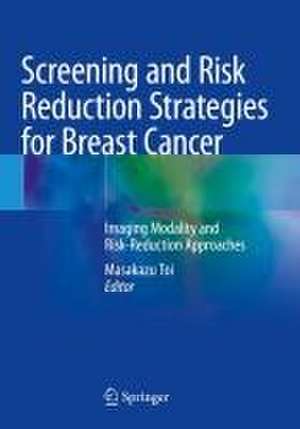Screening and Risk Reduction Strategies for Breast Cancer: Imaging Modality and Risk-Reduction Approaches
Editat de Masakazu Toien Limba Engleză Paperback – 3 mar 2024
A key aim is to demonstrate how multiple diagnostic imaging modalities such as mammography, ultrasonography, MRI, PET and dbPET improve breast cancer screening accuracy. Mammography screening alone may have a limited impact on breast cancer risk prediction. These issues are crucial to discuss. Clinical experts recommend that new modalities be incorporated for women with dense breasts, like ultrasonography, dynamic mammography, MRI and maybe breast-dedicated PET. Topics on these modalities are going to be summarized in this book. An in-depth review of these modalities is summarised in this book. In addition, new diagnostic modalities, including risk assessment tools, multi-cancer early detection tests using liquid biopsy, the role of protein biomarkers in breast cancer risk screening, challenges, and hopes for future advances, are also covered in this book.
| Toate formatele și edițiile | Preț | Express |
|---|---|---|
| Paperback (1) | 705.21 lei 39-44 zile | |
| Springer Nature Singapore – 3 mar 2024 | 705.21 lei 39-44 zile | |
| Hardback (1) | 1102.10 lei 3-5 săpt. | |
| Springer Nature Singapore – 2 mar 2023 | 1102.10 lei 3-5 săpt. |
Preț: 705.21 lei
Preț vechi: 742.33 lei
-5% Nou
Puncte Express: 1058
Preț estimativ în valută:
134.96€ • 140.72$ • 112.16£
134.96€ • 140.72$ • 112.16£
Carte tipărită la comandă
Livrare economică 17-22 martie
Preluare comenzi: 021 569.72.76
Specificații
ISBN-13: 9789811976322
ISBN-10: 9811976325
Pagini: 189
Ilustrații: XII, 189 p. 42 illus., 31 illus. in color.
Dimensiuni: 178 x 254 mm
Ediția:2023
Editura: Springer Nature Singapore
Colecția Springer
Locul publicării:Singapore, Singapore
ISBN-10: 9811976325
Pagini: 189
Ilustrații: XII, 189 p. 42 illus., 31 illus. in color.
Dimensiuni: 178 x 254 mm
Ediția:2023
Editura: Springer Nature Singapore
Colecția Springer
Locul publicării:Singapore, Singapore
Cuprins
1. Introduction of the whole issue.- 2. Breast cancer epidemiology: incidence, risks and subtype.- 3. Personalized genetic breast cancer risk estimation with polygenic risk scores.- 4. Mathematical model forassessing breast cancer risk.- 5. Cost-effectiveness Analysis of multigene testing.- 6. Hereditary breast cancer: Its biology, subtype and clinical phenotype.- 7. Surgical risk reduction of breast cancer.- 8. Medical risk reduction of breast cancer.- 9. Screening for breast cancer with mammography.- 10. Breast cancer screening: Weighing the benefits and harms.- 11. Breast cancer screening according to individual risk.- 12. MRI: Detection of noninvasive diseases.- 13. Significance of MRI for women having dense breasts .- 14. Ultrasound: screening of breast cancer.- 15. Detection of breast cancer by PET.- 16. Radiowave mammography.- 17. Photoacoustic imaging of breast cancer.
Notă biografică
Masakazu Toi, Department of Breast Surgery, Graduate School of Medicine, Kyoto University, Kyoto, Japan.
Textul de pe ultima copertă
This book provides readers with the most up-to-date practical information on breast cancer screening. Since breast cancers are highly heterogeneous, time to clinical onset from the initial carcinogenesis differs diversely between cancers. Pathological germline variants and driver mutations cause a high lifetime risk of breast cancer. The lifetime risks are various according to what genes are pathologically dysfunctional. Integrated omics and imaging technologies have established varying tumour characteristics. Thus, this book suggests that a more individualised scheme is required to improve breast cancer screening.
A key aim is to demonstrate how multiple diagnostic imaging modalities such as mammography, ultrasonography, MRI, PET and dbPET improve breast cancer screening accuracy. Mammography screening alone may have a limited impact on breast cancer risk prediction. These issues are crucial to discuss. Clinical experts recommend that new modalities be incorporated for women with dense breasts, like ultrasonography, dynamic mammography, MRI and maybe breast-dedicated PET. Topics on these modalities are going to be summarized in this book. An in-depth review of these modalities is summarised in this book. In addition, new diagnostic modalities, including risk assessment tools, multi-cancer early detection tests using liquid biopsy, the role of protein biomarkers in breast cancer risk screening, challenges, and hopes for future advances, are also covered in this book.
A key aim is to demonstrate how multiple diagnostic imaging modalities such as mammography, ultrasonography, MRI, PET and dbPET improve breast cancer screening accuracy. Mammography screening alone may have a limited impact on breast cancer risk prediction. These issues are crucial to discuss. Clinical experts recommend that new modalities be incorporated for women with dense breasts, like ultrasonography, dynamic mammography, MRI and maybe breast-dedicated PET. Topics on these modalities are going to be summarized in this book. An in-depth review of these modalities is summarised in this book. In addition, new diagnostic modalities, including risk assessment tools, multi-cancer early detection tests using liquid biopsy, the role of protein biomarkers in breast cancer risk screening, challenges, and hopes for future advances, are also covered in this book.
Caracteristici
Touch upon current topics in breast cancer screening More individualized screening system for breast cancers are focused upon Possible understand background and advances on the risk reduction of breast cancers
